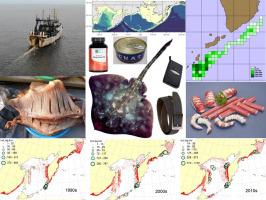当前位置:
X-MOL 学术
›
Prog. Oceanogr.
›
论文详情
Our official English website, www.x-mol.net, welcomes your
feedback! (Note: you will need to create a separate account there.)
Distribution, biology, and relative abundance of the understudied deep-water whiteblotched skate Bathyraja maculata
Progress in Oceanography ( IF 3.8 ) Pub Date : 2024-06-22 , DOI: 10.1016/j.pocean.2024.103300 Igor V. Grigorov , Kirill K. Kivva , Igor V. Volvenko , Alexei M. Orlov
Progress in Oceanography ( IF 3.8 ) Pub Date : 2024-06-22 , DOI: 10.1016/j.pocean.2024.103300 Igor V. Grigorov , Kirill K. Kivva , Igor V. Volvenko , Alexei M. Orlov

|
Our extensive research spanning four decades (1979–2023) investigated the spatial and vertical distributions, dynamics of catch rates (CPUEs), and basic biological features of the understudied deep-water species whiteblotched skate (), which inhabits the North Pacific Ocean. The data used in our study were gathered from publicly accessible databases such as OBIS, GBIF, and AFSC and supplemented by the results of Russian bottom trawl surveys. Our investigation revealed regions with the densest aggregations of whiteblotched skate, notably along the eastern Bering Sea slope, off the Aleutian Islands, in the eastern Sea of Okhotsk, and in the Pacific waters off southeastern Kamchatka and the northern Kuril Islands. Typically, these areas showed the greatest abundance of this species at depths ranging from 400 to 700 m. Remarkably, whiteblotched skates exhibited a migratory pattern toward greater depths during colder months for overwintering, while in the warm period, they predominantly fed at shallower depths. The species also displayed a strong preference for bottom temperatures in the range of 3.1–4.5 °C. Individual whiteblotched skates had a total length spanning from 18 to 127 cm, with the bulk falling within the 50–100 cm range. An intriguing observation was the absence of significant differences in length and body weight between males and females. Additionally, our data revealed that condition factor values reached their peak during the autumn–winter period. Over the years, we observed a substantial increase in the catch rate of whiteblotched skates across most parts of their range. In these areas, the catch rates (CPUEs) initially decreased from the 1980 s to the early 2000 s before increasing.
中文翻译:

正在研究的深水白斑鳐 Bathyraja maculata 的分布、生物学和相对丰度
我们跨越四十年(1979-2023)的广泛研究调查了栖息于北太平洋的深水物种白斑鳐()的空间和垂直分布、捕获率动态(CPUE)以及基本生物学特征。我们研究中使用的数据来自 OBIS、GBIF 和 AFSC 等可公开访问的数据库,并以俄罗斯底拖网调查结果作为补充。我们的调查发现了白斑鳐鱼聚集最密集的地区,特别是白令海东坡、阿留申群岛附近、鄂霍次克海东部以及堪察加半岛东南部和千岛群岛北部附近的太平洋水域。通常,这些区域在 400 至 700 m 的深度范围内显示出该物种的最大丰度。值得注意的是,白斑鳐鱼在寒冷的月份表现出向更深的深度越冬的迁徙模式,而在温暖的时期,它们主要在较浅的深度进食。该物种还对 3.1–4.5 °C 范围内的底部温度表现出强烈的偏好。个别白斑鳐鱼的总长度为 18 至 127 厘米,大部分在 50 至 100 厘米范围内。一个有趣的观察结果是,雄性和雌性之间的长度和体重没有显着差异。此外,我们的数据显示,状况因子值在秋冬期间达到峰值。多年来,我们观察到白斑鳐鱼在其活动范围的大部分地区的捕获率大幅增加。在这些地区,捕获率 (CPUE) 从 1980 年代到 2000 年代初开始下降,然后又上升。
更新日期:2024-06-22
中文翻译:

正在研究的深水白斑鳐 Bathyraja maculata 的分布、生物学和相对丰度
我们跨越四十年(1979-2023)的广泛研究调查了栖息于北太平洋的深水物种白斑鳐()的空间和垂直分布、捕获率动态(CPUE)以及基本生物学特征。我们研究中使用的数据来自 OBIS、GBIF 和 AFSC 等可公开访问的数据库,并以俄罗斯底拖网调查结果作为补充。我们的调查发现了白斑鳐鱼聚集最密集的地区,特别是白令海东坡、阿留申群岛附近、鄂霍次克海东部以及堪察加半岛东南部和千岛群岛北部附近的太平洋水域。通常,这些区域在 400 至 700 m 的深度范围内显示出该物种的最大丰度。值得注意的是,白斑鳐鱼在寒冷的月份表现出向更深的深度越冬的迁徙模式,而在温暖的时期,它们主要在较浅的深度进食。该物种还对 3.1–4.5 °C 范围内的底部温度表现出强烈的偏好。个别白斑鳐鱼的总长度为 18 至 127 厘米,大部分在 50 至 100 厘米范围内。一个有趣的观察结果是,雄性和雌性之间的长度和体重没有显着差异。此外,我们的数据显示,状况因子值在秋冬期间达到峰值。多年来,我们观察到白斑鳐鱼在其活动范围的大部分地区的捕获率大幅增加。在这些地区,捕获率 (CPUE) 从 1980 年代到 2000 年代初开始下降,然后又上升。































 京公网安备 11010802027423号
京公网安备 11010802027423号